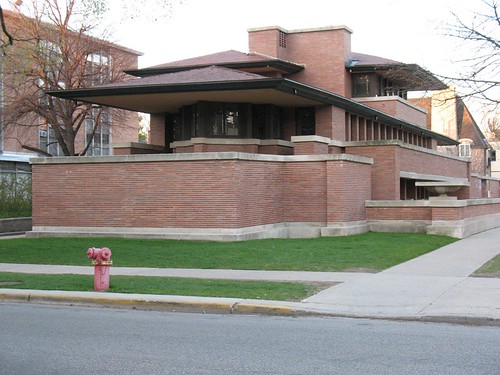A Parisienne in Chicago: Impressions of the World's Columbian Exposition, by Mme. Léon Grandin. Translated and with an Introduction by Mary Beth Raycraft
It is 1893 in Chicago. Just two decades earlier, the city had experienced a fire that destroyed a large part of it. Now it had been rebuilt with energy and innovation. Architects like William LeBaron Jenney, Louis Sullivan, and Holabird and Roche were introducing Chicago and the country and the world to the skyscraper. And Daniel Burnham and the firm of
Burnham and Root were coordinating the building of the Exposition that was to celebrate the 400th anniversary of the discovery of America.
The Columbian Exposition brought to Chicago visitors not only from all over the country, but from all over the globe. Among them were the sculptor, Léon Grandin, and his wife Marie. But their visit was a lengthy one, stretching over ten months, for Grandin was there to work with
Frederick MacMonnies on the
Columbian Fountain. Fortunately for us, Marie Grandin, who had been an elementary school teacher in France, was curious, intelligent, a keen observer, and kept a journal, which formed the basis for her book,
Impressions d'une parisienne à Chicago. Equally fortunate for us, Mary Beth Raycraft has given us a respectful translation as well as an introduction that provides us with background information about Mme. Grandin, and contrasts her experience and book with those of other French women writing about America.
What makes Grandin's observations more substantial than many others is the fact that she did stay in one place for so long. In her ten months here, she stayed in boarding houses and residential hotels; visited schools (as a teacher, a particular interest of hers), stockyards and department stores; and made friends with fellow boarders and the social élite alike (she gave French lessons to
Bertha Palmer, chair of the Expositions Board of Lady Managers).
Of her first glimpse of Chicago, Grandin says,
"The very appearance of [State Street] took me aback and gave me my first inkling of the immense sprawl and grand scale of this city . . . this idea was never dispelled." It's fascinating to read Grandin's images of Chicago, and her comparison of its habits, buildings, customs and people with those of her native France. She is shocked at the relationship between employer and servant, finding the latter insolent and lazy. But she finds the teacher-student relationship, their "easy rapport", far preferable to the "frigid dignity" found in France.
Grandin does not merely describe, she
thinks about what she has seen, she makes considered comparisons and analyses. It's apparent from this that Grandin was a progressive and forward-thinking woman. Her descriptions of American child-rearing practices, the schools she visited, the treatment and behavior of women, all show this.
"This tendency toward social mobility is certainly one of the American virtues that I appreciate the most. Nothing is worse than for an intelligent person to be boxed in and limited. Nothing is worse than being stuck, as only a sense of powerlessness, silliness, and stupidity can come from caged rats."
Perhaps it was this sense of freedom and mobility that led Mme. Grandin to say, as she left the United States, "I will come back!" And come back she did,
sans husband. Raycraft's introduction gives an account of her life after Chicago, which shows (despite the minimal evidence available) that her intelligent curiosity and civic involvement continued to her death.
As a Chicagoan, I enjoyed Grandin's views of places and institutions with which I am familiar. I have attended performances at the
Auditorium Theatre, where she attended a ball. I have shopped all my life at Marshall Field's, visited the animals at Lincoln Park Zoo, am a life member of the Art Institute. To "see" these things through the eyes of a woman of more than a century ago gives one a new perspective and appreciation of them, and, often, a sense of sadness at what no longer exists.
When I walk out the door of my apartment building, turn right, and walk a couple of blocks, I see in front of me the only building that remains standing from the 1893 Columbian World’s Exposition: the Museum of Science and Industry, which is housed in what was the Palace of Fine Arts.
If I keep going, past the Museum and across a bridge, I find myself in an oasis of serenity, an island set in small lagoons, graced by a Japanese Garden, the island also a remnant of that fair. A bit more of a walk, and I come upon a golden woman, “The Republic”, a replica of a larger statue that stood at the gateway Court of Honor. And just to the west is a long park for strolling, ice skating in winter, listening to jazz in the summer, the Midway Plaisance, which, during the Exposition, was a focal point of carnival-style entertainments.
So the history of the Exposition is dear to my heart, and I eagerly opened A Parisienne in Chicago. It did not disappoint. Grandin's writing, as revealed by Raycraft's fluid translation, has an immediacy that compels one to keep reading. The text is accompanied by a section of drawings and photographs of 1893 Chicago that show us what Mme. Grandin would have seen. The endnotes and index are a great help, and there is a selected bibliography for those who are intrigued enough to want to read further, be it about Chicago, French women writers, or the World's Fair. This is a wonderful addition to the literature of women's history, social history and the history of Chicago.
Other suggested reading:
And for your listening pleasure:
 The Blind Contessa's New Machine, by Carey Wallace
The Blind Contessa's New Machine, by Carey Wallace







































